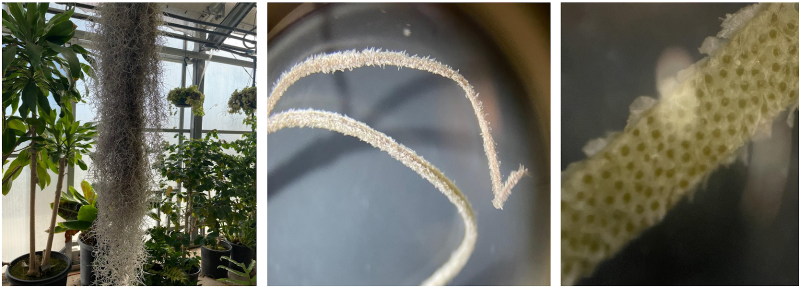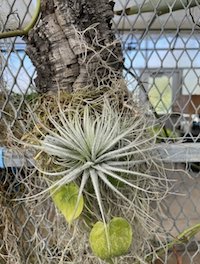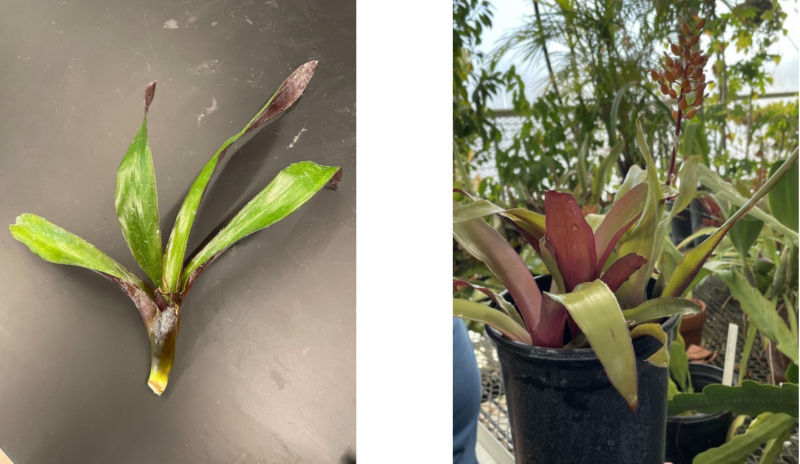By: Andrew Boaru, Monika Carrillo, Brianna Rodriguez, Hira Takhar
Bromeliads come in all shapes and sizes, with over 3590 species present and have existed for roughly 100 million years1! They are mainly located in the tropical Americas but some species are found in the American subtropics and one in tropical west Africa: Pitcairnia feliciana. Here we have information on the various species of Bromeliads that we house here at Stanislaus State, many of which are common in cultivation. Our goal is to present you with visuals and provide context to these awesome plants. We will be overviewing 3 main types of Bromeliads: Terrestrial, Cups, and Epipthyic and observing how they have adapted to various environments primarily in the Americas.
Terrestrial Bromeliads
Terrestrial bromeliads mostly prefer the dry mountainous regions of Chile and other parts of South America. They are able to adapt and thrive in these mountainous regions using CAM2 (Crassulacean acid metabolism) photosynthesis, which aids in preserving water and producing key sugars at a more efficient rate.
The most common bromeliad we find at our local grocery store is a species of pineapple named Ananas comosus. They can grow in a full range of light conditions, from full sun to light shade. An interesting fact about pineapples is their utilization of a chemical called bromelain, which is a digestive enzyme contained in the pineapple's stems. It is used as a defense mechanism against anyone who tries to eat them, which is also why you experience a slight stinging sensation when you eat pineapples3. The pineapple is eating you back!

Images (left to right): A member of the pineapple family, this is the back of the pineapple leaf, notice the white fuzz. The front of the pineapple leaf, notice the lines in the flesh. Image of the entire plant.

Images (left to right): Lindmania chlorantha, can be found in the greenhouse. A cutting, depicting storage tissue. A cross-section of Lindmania. A leaf from Lindmania, notice the small spikes protruding from either side. A cutting under a dissecting microscope.
The genus Dyckia has members residing on the rocky vegetative surfaces of Neotropical savannas, the forests within Brazil, and native countries of Argentina and Bolivia4. Dyckia is a monophyletic group with 150 epiphytic species. Dyckia feature rosettes of small, star-like openings that the leaves sprout from. These rosettes have dense, fleshy leaves that resemble succulent leaves due to their ability to maximize water storage to prepare for long periods of drought5. Dyckia frequently grow on rocky hillsides, which can be hard to grip on, to adapt to this environment, Dyckia has evolved thorny leaves for added grip to their surface. Dyckia also clump together to create a thick blanket that is very hard to remove, this way they can stay firmly in place and trap more water.

Images (left to right): this species of plant is known as Dyckia velascana and can be found in the greenhouse. Back of a Dyckia velascana leaf, notice the lines going down the plant. Front of the Dyckia velascana leaf, notice the spikes protruding from either side of the leaf.
Epiphytic Bromeliads
Tillandsia is a group of bromeliads that are epiphytic in nature, meaning they have roots above the ground rather than below it. Rather than soil, they make their homes on tree trunks or rocks above the ground floor. This is how they get their household names of air plants! With their roots, they pull moisture out of the surrounding air and capture rainfall. Morphologically, they have thin, stiff leaves that are fuzzy, which also aid in water retention. In season, they produce 1-2 inch flowers for reproduction6.
Spanish Moss (Tillandsia usneoides):
The most famous Tillandsia grows in humid, southern regions of the US. It may look a little dried out, but it is healthy and accumulates moisture from the air around it. It can grow on trees but it isn’t parasitic (it’s an epiphyte). Moisture absorption is key for its survival! It has hair-like structures called trichomes on its surface, these help with protection and moisture absorption7.

Images (left to right): Spanish Moss in the greenhouse. An individual piece of Spanish Moss’s hairy surface. A 40x zoom in on a midsection. We observe small hairs for water absorption sticking out!

Tillandsia tectorum is unique in appearance with its very hairy/fuzzy exterior. Traditionally found in the mountains of Peru and Ecuador, they resemble a small snowball in appearance. Due to their higher elevation habitat, they have adapted to become drought-resistant and require little water to survive. Taking in moisture from the air around them for small water droplets. In addition, they are constantly exposed to constant ultraviolet light, and have coped with this by developing large trichomes (fuzzy hairs) to reflect the strong solar radiation. A secondary trait is that these trichomes catch small nutritious particles floating in the wind8.
Cup Bromeliads
Many cultivated bromeliads are in the genus Aechmea. The Aechmea genus which contains over 255 different species9. Aechmea can grow on other plants or trees in a non-parasitic way. They use their cup shaped figure to help collect nourishment such as water and debris of decaying matter. Aechmea will also thrive living in gardens or in pots. For that reason, they are known as popular house plants because of their aesthetic beauty.

Images Left to Right: The first image shows the cup-like figure of Aechmea fasciata that helps collect nourishment. The next image was captured in our greenhouse. It is an image of A. fasciata that is thriving without a host. The third image is an up-close picture of A. fasciata fluorescence. As a result, to its beauty they are commonly used as house plants.

Images Left to Right: Shows the cup-like figure of the Aechmea miniata. Image of A. miniatacaptured in the greenhouse.
Aechmea miniata can be found in the state of Bahia in Eastern Brazil. They thrive in tropical and subtropical regions. Similar to Aechmea fasciata, Aechmea miniata also collects nourishment from its cup-like figure. It is said that the coloration, size, and figure of this plant are due to the colonization of ants10.
References:
- Phylogeny, Adaptive Radiation, and Historical Biogeography in Bromeliaceae: Insights from an eight-locus plastid phylogeny. Givnish et al., 2011. https://givnishlab.botany.wisc.edu/Welcome_files/2011.pdf.
- “Cam Plants.” Kazilek, 2014. https://askabiologist.asu.edu/cam-plants.
- “Bromelain.” National Center for Complementary and Integrative Health, U.S. Department of Health and Human Services, https://www.nccih.nih.gov/health/bromelain.
- Clive Innes "Complete Handbook of Cacti and Succulents", Van Nostrand Reinhold Company, 1981.
- Smith, L.B. & Downs, R. J. Abrometiella in: "Flora Neotropica" 14:241-244 1974.
- “Tillandsia: Characteristics, Habitat, Uses, Care, Species - Science.” Warbleton council, https://warbletoncouncil.org/tillandsia-6097.
- “Dermal Tissue.” Encyclopædia Britannica. Encyclopædia Britannica, inc. Accessed December 1, 2021. https://www.britannica.com/plant/angiosperm/Dermal-tissue#ref596854.
- Christian, C. “Air Plant in Focus: Tillandsia Tectorum Ecuador.” Air Plant Supply Co., Air Plant Supply Co., 18 June 2021, https://www.airplantsupplyco.com/blogs/articles/air-plant-in-focus-tilla...
- Genus Aechmea. iNaturalist United Kingdom. (n.d.). Retrieved December 8, 2021, from https://uk.inaturalist.org/taxa/83927-Aechmea.
- Aechmea miniata - roger clapp greenhouses & littlefield Garden - University of Maine. Retrieved December 8, 2021, from https://umaine.edu/littlefieldgarden/home/plants-in-the-greenhouse/aechm....
Updated: August 08, 2023